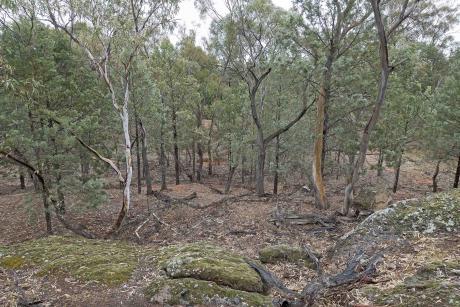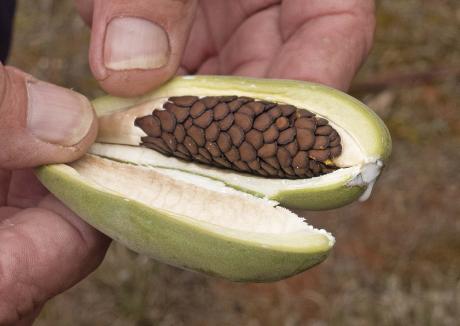Visit to Wirrimbirra Yalul 13 October 2018 - Murrumbidgee Field Naturalists

 A small group of MFNs and Max Harris, a local Koori man, gathered at the Mallinson Road site. After a brief discussion on the unlikelihood of adding new season annuals to our autumn plant survey list, due to the dry conditions, we decided to survey a different site off the Rankin Springs Road. The Wiradjuri name for the site is Wirrimbirra (keep, preserve, take care of) Yalul (always).
A small group of MFNs and Max Harris, a local Koori man, gathered at the Mallinson Road site. After a brief discussion on the unlikelihood of adding new season annuals to our autumn plant survey list, due to the dry conditions, we decided to survey a different site off the Rankin Springs Road. The Wiradjuri name for the site is Wirrimbirra (keep, preserve, take care of) Yalul (always).
Wirrimbirra Yalul has rocky outcrops on a hill with gentle slopes that lead down from it. It’s several hectares in area but due to frequent rain showers which eventually became heavier, we didn’t explore the entire patch. On our arrival, Max pointed out stone artefacts (and their traditional uses) near the remains of a gravel deposit. He was very informative about Wiradjuri history and culture as well as the flora and fauna of the place. We had interesting exchanges about cultural bias with scientific names and common names, in English and Aboriginal languages. Max is well versed in all three naming systems and is very generous in sharing his knowledge.
In listing the plants and birds we noted at Wirrimbirra Yalul, the Wiradjuri names are added as they are recorded in “A New Wiradjuri Dictionary” compiled by Dr. Stan Grant (Senr) and Dr. John Rudder,2010. Words with * indicate they can be heard on the Free Wiradjuri Language App where they are pronounced by Wiradjuri speakers, listed under the English common name. There are hundreds of words and phrases listed there to explore. A brief pronunciation guide for readers not using the App is provided at the end of the list.
Many of the common names for flora and fauna in our region are Wiradjuri names with anglicised spellings and pronunciation influences. Where the English common name and the Wiradjuri name have the same or very similar pronunciation, the spelling difference is partly due to the reformed spelling system developed in the dictionary. More than one Wiradjuri name often exists for the same plant or animal for similar reasons that more than one English common name exists. Wiradjuri people live across an enormous part of central southern NSW, so regional variations naturally exist in the language.
Plants
Isotoma axillaris – Showy Isotome, Pittosporum phylliraeoides – Butterbush or Native Apricot, Sclerolaena diacantha – Grey Copperbur or Two Spined Saltbush, Sida corrugata – Corrugated Sida, Sida cunninghamii – Ridge Sida, Einadia nutans – Creeping Saltbush, Vittadinia cuneata – Fuzzweed, Chrysocephalum semipapposum – Clustered Everlasting, Alectryon oleifolium – Rosewood,
Brachychiton populneus – Kurrajong = GARRADYANG*
Santalum acuminatum – Quandang = GUWANDANG*
Callitris glaucophylla – White Cypress Pine = BURRADHAA, GARRAA*
Dodonaea sp – Hop Bush = BURURR*
Eucalyptus microcarpa – Grey Box = MURRUNG*
Casuarina cristata – Bull Oak or Belah = BIILAA, NGANY*
Exocarpos cupressiformis – Native Cherry = MAMBARRA*
Eucalyptus dwyeri – Dwyers Mallee = BANDHUNG, BANDHUWANG*
Eucalyptus socialis – Pointed Mallee = BANDHUNG, BANDHUWANG*
Hakea leucoptera – Needlewood or Needlebush = YURI*
Native Banana = BUGURR* (vine)
Acacia sp – Wattle = MUDHAMADHANG* (many names exist for specific species)

